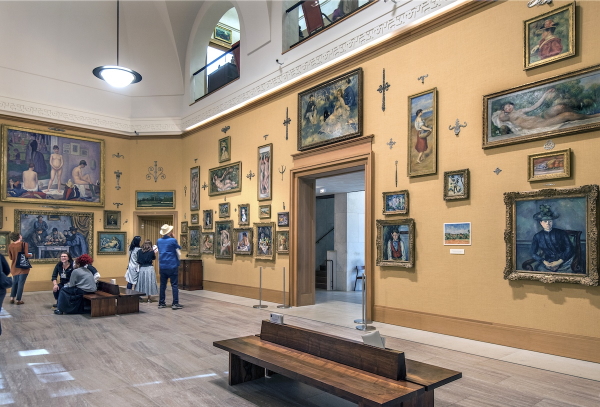[This local story from Technical.ly Philly describes a new program that uses presence to bring the virtual and in –person experience of art to more members of the community. See the original story for a second photo and the version in Generocity Philly for more images. –Matthew]

[Image: Inside the Barnes Foundation. Credit: R. Kennedy for Visit Philadelphia]
Virtual reality is bringing the Barnes’ art to Philly seniors — and vice versa
“It’s a way to go into communities, meet them where they are, invite them into the museum, and then encourage them to come back,” said Ana Gamboa, the museum’s special project coordinator.
By Hannah Chinn / Contributor
October 2, 2019
It’s no secret that Philly has some of the best art museums in the United States: Travelers from all corners of the globe come to visit the Barnes Foundation, Philadelphia Museum of Art, Pennsylvania Academy of the Fine Arts and more every year.
But when it comes to neighborhood engagement, there’s often a disconnect: though the city is incredibly diverse, its local museum-goers often aren’t.
Low-income communities and communities of color face both financial and cultural barriers when it comes to museum access. The Barnes is aiming to change that.
Exhibit A? The elderly Black visitors following their guide through the museum this Friday afternoon, brought here through the Barnes’ new virtual reality program.
Here’s how it works: First, museum educators — called “community connectors” — bring virtual reality headsets into a neighborhood location like a public library, a rec center or a senior residence. The headsets, developed with support from the Barra Foundation, are binocular-like devices that hold a smartphone, allowing the user to “explore” the gallery rooms through immersive, 360-degree images.
After seeing the Barnes collection virtually, participants are invited to visit it in person. There, they’ll be guided through the museum by the same community connector who first handed them the headset.
This Friday’s seven visitors are from a senior center in Olney, and they’re excited to be here. Some of them point out pieces they remember from the VR tour, while others move closer to see pieces they hadn’t noticed before. One woman, rings stacked high on every finger, takes pictures of every large painting she sees, then looks at them and laughs delightedly to herself.
“The VR’s are better than looking at a still picture,” says David Turner, 77, gesturing his cane for emphasis. “It really puts you in the room.”
“[The VR] made me want to come,” adds Gloria Drummond, 79, a soft-voiced senior in a rose-colored skirt suit. “It was quite an experience.”
For Turner and Drummond, this visit marked their first time using VR headsets. It also marked their first time at the Barnes.
They aren’t alone. In 2018, when the Barnes began the program, 80% of field trip participants were first-time visitors; 14% of the returners hadn’t visited the Barnes in more than two years. Barbara Wong, Barnes’ director of community engagement, says that’s the whole point.
“Virtual reality became an opportunity around building relationships where communities are. There’s a lot of interest out there, but museum spaces aren’t always accessible,” she said, “so we’re taking our collection out, going where the people go, taking a high-tech tool and creating this low-tech experience.”
Last year, the Barnes partnered with the Free Library of Philadelphia to offer VR headsets at five sites throughout the city. In 2019, they’ve run the program at 31 sites and reached over 600 people — and counting.
“Whenever possible, we want to encourage them to see the real thing,” Wong said. But the ultimate goal is to connect program participants to the museum’s offerings in a lasting way. “We say art is for everyone. … I think there’s a huge benefit to virtual reality in that it can take these wonderful resources and share them with a community that might not otherwise be able to access [them].”
That includes everyone, from age five to 105.
“We’ve had entire family groups sometimes — grandparents, parents, and kids — show up at the museum together,” she said. “We never really know who will arrive.”
“But we want everybody to come,” added Sarah Wagner-Bloom, one of the project’s community connectors.
As a native Philadelphian (she grew up only four blocks from the Barnes’ current site), Wagner-Bloom says local engagement with museums has always been important to her. Even though the Barnes’ home in the city is fairly new, she pointed out, the collection itself has belonged to the area for nearly 100 years: “There’s no reason Philadelphians shouldn’t be able to access it and treat it as their own.”
The Barnes is the first museum in the region to use VR technology to engage visitors in this way. Ana Gamboa, who oversees the program as the Barnes’ special project coordinator, says they’d love to see other institutions adopt similar approaches.
“It’s a way for [museum educators] to … go into communities, meet them where they are, invite them into the museum, and then encourage them to come back,” she added.
It’s that final step — coming back — that indicates participants’ desire to engage with the collection again, on their own time. And as the Friday tour wraps up, its participants are considering just that.
“I’ve been trying to get to this museum for a long time,” Drummond says. She smooths her rose-colored skirt down and nods when Wagner-Bloom asks if she enjoyed the art. “I was really just mesmerized by it.” Still, she adds, she didn’t have enough time to see everything. She wishes she could’ve stayed longer.
That’s when Gamboa returns to hand out Barnes Community Passes, which allows program participants to return anytime in the next year (and bring a visitor with them).
“Now are you going to come back?” Wagner-Bloom asks.
Drummond laughs. “Now I’ll certainly try.”
Leave a Reply